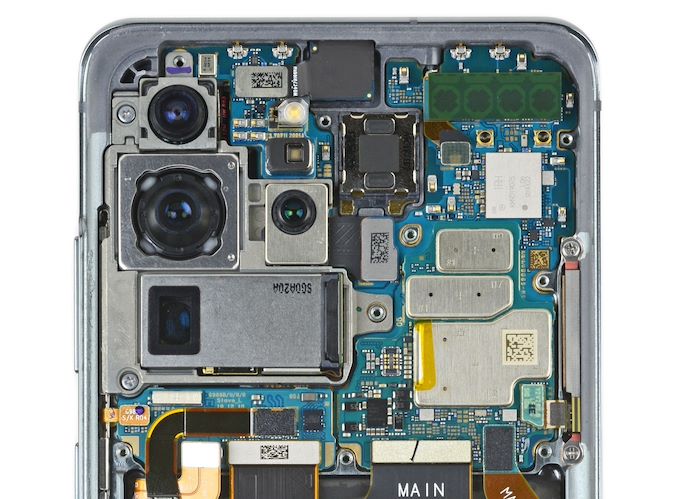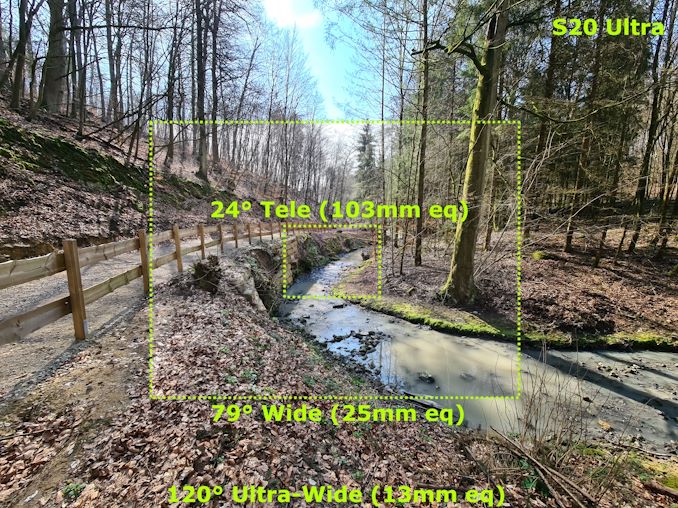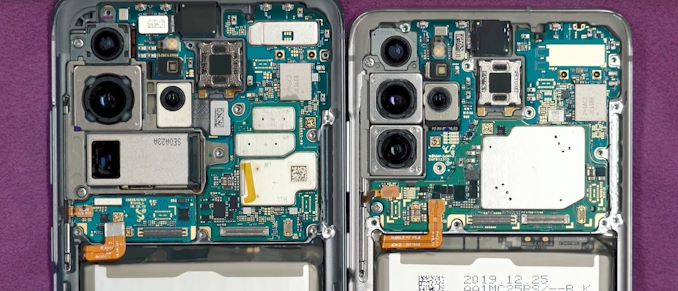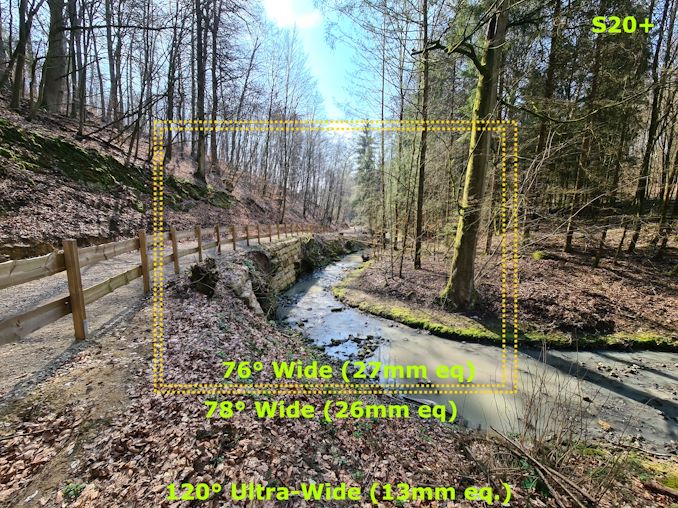The Samsung Galaxy S20+, S20 Ultra Exynos & Snapdragon Review: Megalomania Devices
by Andrei Frumusanu on April 3, 2020 9:30 AM ESTCamera Architecture: Huge New Sensors
As we move on to the camera evaluation of the S20 series, I think it would be good to recap the new sensor architectures that Samsung is deploying in its new flagships. To say that this is the biggest camera hardware upgrade that Samsung has ever embarked on is a bit of an understatement, as the new modules on the S20 series, and in particular the S20 Ultra, have seen some fundamental shifts in terms of their designs and specifications.
| Samsung Galaxy S20 Series Cameras | ||||
| Galaxy S20 | Galaxy S20+ | Galaxy S20 Ultra | ||
| Primary Rear Camera | 79° Wide Angle 12MP 1.8µm Dual Pixel PDAF |
79° Wide Angle 108MP 0.8µm DP-PDAF 3x3 Pixel Binning to 12MP 8K24 Video Recording |
||
| fixed f/1.8 optics OIS, auto HDR, LED flash 4K60, 1080p240, 720p960 high-speed recording |
||||
| Secondary Rear Camera |
76° Wide Angle (Cropping / digital zooming telephoto) 64MP 0.8µm F/2.0 optics, OIS 8K24 Video Recording |
24° Telephoto (5x optical magnification) 48MP 0.8µm 2x2 Pixel Binning to 12MP F/3.5 prism optics, OIS |
||
| Tertiary Rear Camera |
120° Ultra-Wide Angle 12MP 1.4µm f/2.2 |
|||
| Extra Camera |
- | Time of Flight (ToF) 3D Sensor | ||
Starting off with the elephant in the room, that’s the new S20 Ultra. Last year we first saw talk of Samsung LSI introducing a new 108MP camera sensor that had been developed in collaboration with Xiaomi. Although closely related to that design, the HM1 sensor is a bit different to the HMX sensor that’s employed in the Xiaomi phones. What’s special about these new sensors is their sheer size: at 1/1.33”, it’s over double the sensor area of previous generation units found in past Galaxy phones. A lot of people will criticize the 108MP count as being a gimmick, but in light of the huge new sensor the actual pixel pitches aren’t exactly all that smaller than what we’ve seen from previous generation high-megapixel sensors from the last year or two, still falling in at 0.8µm.
![]() Source: TechInsights
Source: TechInsights
What’s rather peculiar about the HM1 sensor in the S20 Ultra though is that this isn’t just another quad-Bayer sensor like those seen in other designs over the year, but rather a “Nonacell” design, with the color filter array covering up 9 subpixels. Just like quad-Bayer designs, the new nona-Bayer sensor is able to demosaic chroma information to be able to actually achieve the advertised 108MP resolutions. Physically, chroma resolution still is only 12MP on the sensor, and that’s something that you’ll want to keep in mind when we’ll later on investigate the 108MP samples of the phone.

Source: iFixit
As seen in the above teardown shot, the 108MP unit dwarfs the other sensors in the phone, but this does come with some complications. On the optics side, Samsung has now opted for a fixed f/1.8 aperture and has dropped the dual-aperture f/1.5-2.4 system we’ve seen on the S9 and S10 series. Because the new sensor is so huge, it actually becomes an issue to design proper optics that actually fit into the z-height of the phone. Even though the S20 Ultra has a thick camera bump now, it still has to make do with a smaller aperture optical lens than previous generations. The new bigger sensor also has another side-effect, that being a shallower depth of field when focusing on objects. I do find it a very big pity that Samsung opted to drop the dual-aperture system as that would have been the perfect fit for such a big sensor design and essentially eliminate any potential drawbacks on the optics side. Unfortunately, as it’s gone, I do expect the optics to not perform quite as optimally as we’ve seen on the S10 series.
Below the 108MP sensor, we find another unique design that’s exclusive to Samsung at this moment, and that’s the new periscope design telephoto module. Such modules were pioneered by Huawei as we first saw the P30 Pro last year bring it to the mass market, however Samsung goes way beyond what any other vendors is currently brining to the market. The optical magnification of Samsung’s design isn’t too special, only reaching a factor of 4x and a resulting 24° field of view or 103mm equivalent focal length. What is special though is that Samsung has crammed in a full 48MP IMX586 into the module, going far beyond the smaller 12 or 8MP sensors that are being deployed by other vendors such as Huawei. It’s the usage of such a big sensor that lies perpendicular to the body of the phone that actually forces the S20 Ultra to have such a huge camera bump on the back – as it’s being limited by the thickness and the footprint of the telephoto camera module.

To square off the trio of cameras on the S20 Ultra, we see a new ultra-wide-angle module. Samsung here opted to go for a lower megapixel count sensor at 12MP compared to 16MP on the S10 series, but the pixel pitch increases from 1.0µm to 1.4µm, which should allow it go achieve better per-pixel sharpness and low-light capturing abilities. It remains quite wide at a 120° viewing angle, just a tad tighter than 123° unit on the S10 series.
When looking at the different viewing angles of the S20 Ultra, we see some big discrete steps between what the different sensors are able to natively capture at their fullest. The main sensor on the S20 Ultra is actually a tad wider than what Samsung is marketing, and it produces 25mm equivalent focal length images, a little wider than the 26mm of the S10 series and the other S20 phones. Of course, the telephoto lens will have a small field of view of only 24°, but that’s precisely what allows it to achieve such high magnification levels, also thanks to the high resolution captured within this frame.

Source: ITSub
While the S20 Ultra’s camera design is fascinating, the design that actually excited me a lot more when the phones were first introduced is the camera trio that’s found on the regular S20 and S20+. Here Samsung is using a completely different approach that’s pretty much unique in the industry.
Starting off with the main sensor, this is seemingly a pretty straightforward design that really only differentiates itself through the fact that’s it’s now a bigger sensor falling in at 1/1.76”. The resolution still is 12MP and it’s a regular Bayer sensor, so pixel pitches now grow to 1.8µm. The optics remain similar to the S20 Ultra’s, coming with a fixed f/1.8 aperture lacking the dual-aperture system and of course also includes OIS. The Ultra-Wide-Angle is also the same as on the S20 Ultra.
What’s really exciting about the S20 and S20+ is the “telephoto” module. The weird part is that this isn’t a telephoto module at all, but it’s an actual secondary wide-angle lens that’s only slightly tighter than the main camera. The sensor here is also large at 1/1.76”, but it comes a 64MP resolution with 0.8µm pixels. I actually haven’t heard confirmation of the color filter array of the unit, whether it’s quad-Bayer with remosaic or whether it’s a true 64MP Bayer sensor.
Why Samsung is able to call this a 3x telephoto module is that when cropping a 1:1 12MP picture out of it, it does end up at a 3x magnification in relation to the main camera sensor. The question you’re of course posing, is why would Samsung go for such a camera configuration? The first answer, possibly the most obvious one, is 8K video recording. As the main camera unit’s 12MP native resolution isn’t sufficient for 8K video recording, Samsung needed to find a way to include this into the regular S20 series as well – and obviously if you had an actual telephoto module for this then you’d end up with a pretty useless setup. Going for a secondary wide-angle module kills two birds with one stone, as you have one module being able to serve as the 8K video recording unit as well as taking advantage of the high-megapixel count of the unit to be able to achieve respectable crop-zooming.
I was most excited about this setup, more-so than that of the S20 Ultra, because it opens up a lot of possibilities in terms of sensor fusion and computational photography that’s physically just not possible on the S20U. Without spoiling the camera evaluations too much, this also means that the S20 and S20+ have quite high quality zoom capabilities in the 1-3x range as well, and it doesn’t behave as a “normal“ telephoto module at these intermediate levels.











137 Comments
View All Comments
iphonebestgamephone - Sunday, April 5, 2020 - link
Oh and what does a pro like you use?sanjeev.k - Saturday, April 4, 2020 - link
Hi Andrei,Thanks for your detailed review. Any change Anandtech will be reviewing the note 20 later in the year (as Anandtech have not reviewed the note xx series past few years) ?
Reliable leaker @IceUniverse hints that Note series will implement an optimised solution for 120 Hz refresh rate - so I am assuming that to mean that power inefficiency issues at 120 hz refresh rate will be fixed in the note series.
If you are going to review the Note series, at least we will know whats the improvement like as compared to Galaxy S series. Then I can decide if I want to import the Snapdragon 865 Note series or import S20 865 series and bear with the 120 Hz power consumption issue
abufrejoval - Saturday, April 4, 2020 - link
I bought the first Galaxy Note for its size: My hands are much more capable than my eyes up close. I stuck around for the Note 3 and then abandoned the brand as they went off into Absurdistan with too much glass and metal replacing replaceable batteries (both Notes still work today with 2nd and 3rd sets of batteries).But I’ve always longed to see another feature become mainstream usable, that these Notes started, albeit with serious functional limitations: Desktop or docking mode.
The Note 2 dock also worked with the Note 3 and it was the first that I tried to use for extra light business travel with a foldable BT keyboard even a BT mouse on an HDMI connected big screen. Mixed DPI support wasn’t quite up to snuff, even with custom ROMs that added Ethernet connectivity (security constraints mandated that in some cases).
In terms of computing power everything since the 820 has been enough for me in mobile use: If I really want to crunch numbers, I use HPC servers which I access via SSH, RDP or VNC and gaming is much more fun with an RTX 2080ti.
Phones as a VR headset replacement died far too quickly for my taste, my Le Max2 with its Le VR “luxury cardboard” companion still works pretty well, certainly for 3D movies.
So, the only reason I would even remotely consider buying one of these overpowered smartphones is if they could do double-duty as mid-line laptop replacements. Unless Corona’ed I switch countries every week and taking a €1200 smartphone instead of a €1200 laptop along for the ride, while enjoying a 43”@4k desktop in both offices has a great appeal, especially since RAM (16GB), storage (500GB) and compute power are similar enough to satisfy me.
I need both to handle the typical office/productivity stuff, surfing and the ability to access the big systems, be they compute farms or GeForce Now if I am in need for a monster kill. Yes, I love to be able to even run a Docker container in case I want to code something on the quick and up to chroot() that works pretty well with Android’s Linux kernel, even if it’s not quite as podman ready as the laptop.
Last Samsung I got was a Tab S5e a month ago and its DEX qualities are really much improved. It has perhaps 25% of the power and capacity of these phones (at 50% price) but shows what could obviously be done here. Yet I see no mention of DEX on the S20 and I fear that Samsung’s product management is…
The mere existence and perseverance of Exynos SoCs and rounded display edges prove that these people must be insane: Very sad, when you consider what the hardware could actually do!
In the mean-time I am holding on to a very nice OnePlus 5 as daily driver, lovingly protected with a silicon sleeve that sports an elevated ridge around a flat display thus kept from drop’s harm with grip and buffer space. When I take it out for a bit of soap and water treatment, it looks like new.
Chassis materials, colors, design, finger tip smudges? I couldn’t care less and the Note 1-3 removable plastic covers were plain perfect for longevity and flexibility.
Rorange68 - Saturday, April 4, 2020 - link
Great review.. somehow I haven’t seen these in the past but will watch for them now. Quick question... the chart on the first page shows all of the versions with dual sims.. a nano and esim. I was thinking of going for the Exynos because it’s been the only one listed as having dual sims but given the issues with 5g compatibility and the review you give it that seems like a really bad idea But if they all have dual sim it would make it a lot easier to leave my 10+ and get the 20+ or even splurge on the ultra on the chance they improve some of it via software updates.Rorange68 - Saturday, April 4, 2020 - link
*5g comparability between for the Exxon’s version and US carriersMarcSant - Saturday, April 4, 2020 - link
Outstanding! The Anandtech articles are simple the best, the definitive tech guide for all tech lovers. Keep up with the high level of these tech articles that in my opinion are the "must go" for all people that are interested in buy a gadget and see the "behind scenes" information that manufactures will not tell you.airdrifting - Saturday, April 4, 2020 - link
No thanks on overpriced, never last, slow update, buggy software Korean garbage.surt - Saturday, April 4, 2020 - link
Do they have a reputation for not lasting? I'm considering this for an upgrade from my Galaxy S6 which is still working fine but I'd like a better camera.airdrifting - Saturday, April 4, 2020 - link
I haven't tried the newer ones, but I owned Galaxy S1, Galaxy S3, LG G2 and G3, none lasted 2 years (G2 being the best one imo.). I switched to Oneplus after that. Oneplus 3T lasted almost 3 years, now I am rocking a Oneplus 7 which I paid $400 for on eBay.shabby - Sunday, April 5, 2020 - link
Lol how about you get a newer phone before bashing it.